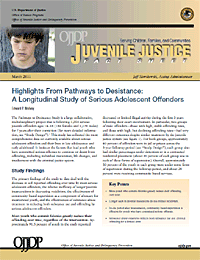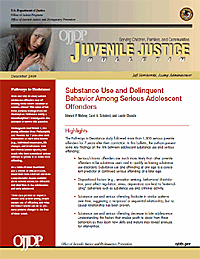At the February 10, 2012, meeting of the Coordinating Council on Juvenile Justice and Delinquency Prevention, invited guests Edward P. Mulvey, Ph.D., director of the Law and Psychiatry Program at the University of Pittsburgh School of Medicine; and Carol Schubert, the medical school's research program administrator, offered key policy recommendations for promoting desistance from crime among youth who have committed serious offenses. The recommendations are based on an OJJDP-supported longitudinal study, Pathways to Desistance, led by Mulvey.
Researchers conducted more than 21,000 interviews over 8 years with more than 1,300 felony offenders ages 14–18 in the cities of Philadelphia and Phoenix. Researchers also interviewed parents and peers and examined arrest records.
Following are findings and policy recommendations presented by Dr. Mulvey and Ms. Schubert at the council meeting. A more detailed explanation of the study's findings may be found in the publications cited in the sidebar below, "OJJDP's Pathways to Desistance Publication Series."
- Finding: Adolescents who have committed serious offenses are not necessarily on track for adult criminal careers. Only a small proportion of the offenders studied continued to offend at a high level throughout the followup period. In addition, serious juvenile offenders vary considerably in patterns of offending, risk factors, and life situations.
- Finding: In jails, prisons, and residential facilities, adolescents with mood/anxiety problems were no more likely to receive mental health treatment than those without such problems. In addition, institutional environments that emphasize positive youth development rather than harsh punishment decrease the probability of future antisocial activity. Adolescents who perceive their institutional experience more positively have better outcomes.
- Finding: Longer stays in juvenile facilities do not reduce reoffending; institutional placement raised offending levels in even those with the lowest level of offending. In contrast to youth in institutional care, youth who received community-based supervision and aftercare services were more likely to attend school, go to work, and avoid further offending during the 6 months after release, and longer supervision periods increased these benefits.
- Finding: Substance use is a major factor in continued criminal activity by serious adolescent offenders. Substance abuse treatment for young offenders reduces both substance use and non-drug-related offending if the treatment period is long enough and if families take part in the treatment with the offender.
Recommendation: A youth's presenting offense is a poor predictor of future recidivism or positive development. To increase the impact of justice interventions, promote policies that address adolescents' individual patterns of offending, risk factors, and needs; and target services to the highest-risk offenders.

Edward P. Mulvey, Ph.D., professor of psychiatry and director of the Law and Psychiatry Program at the University of Pittsburgh School of Medicine, discusses the findings and policy implications of a longitudinal study showing, among other findings, that substance use is a major factor in continued criminal activity by serious adolescent offenders. On the left is Carol Schubert, research program administrator, University of Pittsburgh School of Medicine.
Recommendation: Promote procedures, policies, and assessment tools that review whether adolescent offenders are receiving services in institutional care matched to their needs and promote periodic assessment of institutional environments from the perspective of the adolescents in their care.
Recommendation: Reduce the rate of placement of serious adolescent offenders in institutions as well as the duration of these placements. Increase the level of community-based services to these adolescents.
Recommendation: Increase the provision of substance abuse prevention services to serious adolescent offenders in both institutions and in the community, ensuring that the services are of adequate intensity and that they involve family members.
"The study shows that there is a strong relationship between crime and substance abuse," said Terry Zobeck, Associate Director for Research/Data Analysis at the White House Office of National Drug Control Policy, in commentary following the presentation. "If we're going to have any success in reducing substance abuse, we need to address that association. Substance abuse magnifies and makes the problem of crime so much worse among these populations. Those offenders who receive treatment have better outcomes on rearrest."
OJJDP's Pathways to Desistance Publication Series
In December 2010, OJJDP launched a publication series presenting the findings of the Pathways to Desistance study. This study has collected the most comprehensive data set currently available about serious adolescent offenders and their lives in late adolescence and early adulthood. Following are the publications released to date:
 Highlights From Pathways to Desistance: A Longitudinal Study of Serious Adolescent Offenders
Highlights From Pathways to Desistance: A Longitudinal Study of Serious Adolescent Offenders
This fact sheet presents an overview of findings from the Pathways to Desistance study. The primary findings of the study to date deal with the decrease in self-reported offending over time by most serious adolescent offenders, the relative inefficacy of longer juvenile incarcerations in decreasing recidivism, the effectiveness of community-based supervision as a component of aftercare for incarcerated youth, and the effectiveness of substance abuse treatment in reducing both substance use and offending by serious adolescent offenders.
 Substance Use and Delinquent Behavior Among Serious Adolescent Offenders
Substance Use and Delinquent Behavior Among Serious Adolescent Offenders
This bulletin presents key findings on the link between adolescent substance use and serious offending. Serious/chronic offenders are much more likely than other juvenile offenders to be substance users and have related disorders. Dispositional factors (sensation seeking, disinhibition, poor affect regulation, stress, depression) can lead to externalizing behaviors such as substance use and criminal activity. Studying the factors that help youth desist from these behaviors may reveal avenues for intervention.
Future publications in this series will address the transfer of adolescents to adult court; psychosocial maturity and desistance from crime; mental health services for serious adolescent offenders; deterrence among high-risk adolescents; and cultural orientation, substance use, and offending among Mexican American youth offenders.
Resource:
For more information about the Pathways to Desistance study, visit its Web site.
